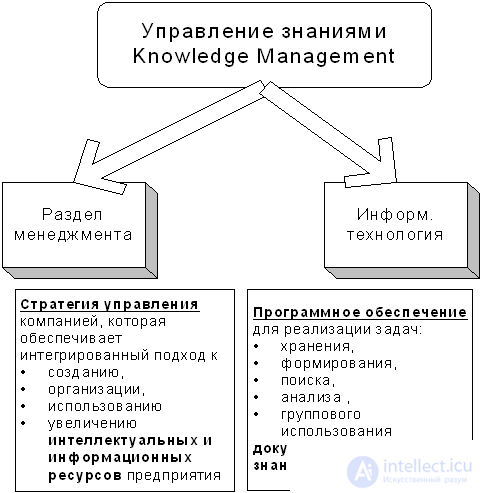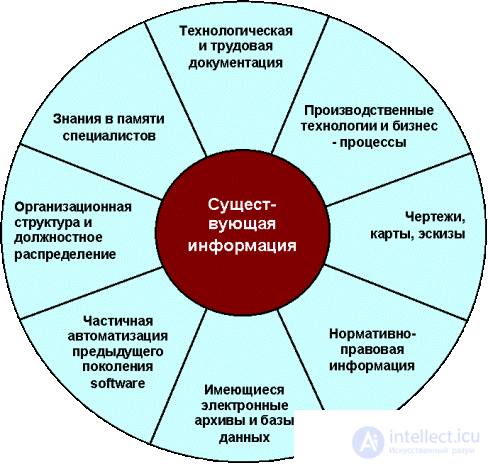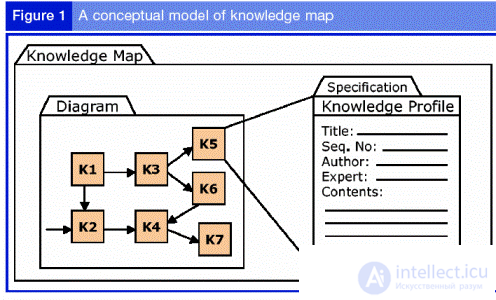Lecture
Knowledge management is a fashionable and relevant topic. The issue of the company's readiness for its implementation was devoted to our previous article.
It is rather difficult for a modern top manager to understand among the “zoo” of new informational trends, software systems and products. Is there a real need for these very expensive ERP, workflow, CALS, CRM and other abbreviations. New terms appear with a frequency of six months, and with the same speed disappear from the horizon. Does the knowledge management system (KMS) apply to them? Is the company able to implement such a system?
Only an experienced and honest high-level analyst can suggest the right direction of automation by understanding the real management system and information infrastructure of the company, on the one hand, and being competent in the features and novelties of the automated systems market. Such specialists are not being trained anywhere, and craftsmen who have been lovingly grown at enterprises are overloaded with tactical “patching” of holes, and not with strategic analysis. For obvious reasons, these people can not be in the IT-companies (IT - Information Technologies), accompanying and implementing a specific product.
The way out of this impasse is not invented by us - it is the services of consultants and / or the training of analysts at the enterprise. The training of analysts is so difficult that it deserves a separate discussion.
The task of a professional consultant-analyst is to understand the specifics of the main difficulties of the enterprise and recommend the implementation of the system that solves the existing problems as simply and easily as possible.
In reality, everything happens exactly the opposite - first, IT specialists choose a tool (influenced by advertising, lobbying, personal preferences, interest, and their understanding of automation), and then they are convinced that the top managers are right. This practice is old, as is the automation itself, as well as the snobbish slogan of the first automatists during the Soviet automated control systems: “Let's make the client not what he asks, but what he needs!”
This article focuses on practical steps to create a CPS company.
The concept of " knowledge management" appeared in the mid-1990s in large corporations, for which the problems of processing information became particularly acute and became critical. At the same time, it became obvious that the main bottleneck is working (saving, searching, replicating) with the knowledge accumulated by the company's specialists, since it is knowledge that provides an advantage over competitors. Usually, information in companies has been accumulated even more than it is able to quickly process. At the same time, often one part of an enterprise duplicates the work of another simply because it is impossible to find and use knowledge that resides in neighboring divisions.
Various organizations are trying to solve this issue in their own way, but at the same time each company seeks to increase the efficiency of knowledge processing.

Fig.1. Ultrasound duality
In fact, “Knowledge Management” can be viewed both as a new direction in management, and as a direction in computer science to support the processes of creation, distribution, processing and use of knowledge within an enterprise (Fig. 1)
The new concept of "knowledge management" really helps to change the view on the automation of the corporation, as it focuses on the value of information. The novelty of the concept of ultrasound is a fundamentally new task - to accumulate not only fragmented information, papers, graphics, files, but also knowledge, i.e. laws and principles that allow to solve real production and business problems. At the same time, the knowledge that is “invisible” is taken into account - it is stored in the memory of specialists, and not on tangible media.
Knowledge resources vary by industry and application, but typically include guides, letters, news, customer information, competitor information, and technology accumulated during the development process.

Fig. 2. “Flower“ informational components
These resources themselves can be located in various places: in databases, knowledge bases, in card files, with specialists and can be dispersed throughout the enterprise. A variety of information components is presented in Fig.2.
Traditionally, designers of KM systems (KMS) focused only on individual groups of consumers - mainly managers. More modern control systems are already designed for an entire organization.
Because of this diversity, KMS is forced to integrate a variety of technologies:
e-mail and Internet resources;
database management systems (DBMS) and the databases themselves (DB);
tools for creating data warehouses (Data Warehousing);
group work support systems;
local corporate automation systems;
workflow and workflow systems;
knowledge portals, expert systems, etc.
At the same time, none of these technologies (except for the latter) include “knowledge” in the context of intellectual (expert) systems, i.e. knowledge bases.
The vagueness of differences in terms of “information”, “data” and “knowledge” pours water on the mill speculation on this topic. If we interpret information as a general term for all information resources of an enterprise, then in reality many modern KMS deal with the problem of organizing only a part of information, mainly document circulation in a company.
The “bridge” to intellectual technologies is the concept of “knowledge”, which is interpreted in the UZ extremely freely and widely. CPS knowledge refers to all types of information (they include manuals, letters, news, customer information, information about competitors and technology accumulated during the development process), while traditionally knowledge means the laws of the subject area that allow specialists to solve their problems. They are derived from practical experience or drawn from the literature.
In fact, systems that position themselves as CPS - knowledge management systems (Fulcrum, Documentum i4, Knowledge Station, etc.) [Popov, 2001] implement only certain elements of the above list. All of them work with either unstructured information in the form of documents or data.
If you are not afraid of the complexity, then the minimum practical algorithm for creating a CPS, which is also the life cycle of the ultrasound is presented in Fig.3.
The circular character of the diagram shows the cyclical nature of the process and the need for ongoing support and system upgrades. So ,
Step 1. Needs analysis
The main thing is to clearly define the goals of the system, its specific users and their interests. This step will require a rigorous analysis of the organization’s information flows and the interviewing of potential users of the system. At this stage, a feasibility study of the entire KMS project is carried out.
In the absence of generally accepted methodology and technology, this process is not a trivial task. It requires developers to be proficient in knowledge engineering technologies, from knowledge extraction techniques to structuring and formalization [Gavrilova, Khoroshevsky, 2000].
The first step involves a deep structural analysis of the subject area. Such work for intelligent systems is usually performed by knowledge engineers (knowledge engineers). For more advanced companies, special knowledge managers are created.
Unfortunately, there are still very few professionals who know the methods of knowledge engineering. The closest are the specialties of a systems engineering engineer and an information technology (IT) specialist. Although the latter, most often just programmers. The existing first attempts to train specialists of a wider profile, such as the CIO (Chief Information Officer), or MBI (Master of Business Information) specialization, should be welcomed, but they are more focused on IT managers rather than analysts. The first “School of Analysts” also appeared, but the number of their graduates was not very significant for changing the situation.
For example, in a software company “Super-software” with 120 people, a group of three analysts was created (two were hired specially, one of them was a consultant), who within six months identified the main “knowledge carriers” of the company or “experts. Also identified:
document flow scheme
core business processes
archive structure
"Holes" and bottlenecks in the process of circulation of information
Step 2. Search and retrieve information
The most time-consuming step, which includes analyzing documents, working with all sources of information, including experts. Fragments of informational content are formed, sources of information provision are identified. For each expert, an information profile is created that characterizes the area of expertise of the specialist. There are more than a hundred specialized methods for extracting knowledge, the use of which is determined by the characteristics of the company's business and the professionalism of analysts. In Super-Soft, analysts conducted more than 50 interview sessions with experts and simply with developers. Experts, in addition to fame, received awards for additional work. Working with documents required the inclusion of another technologist (documentation specialist) in the group. Fig.4. illustrates one of the possible types of knowledge maps.
Step 3. Structuring
The conceptual structure that the organization uses is revealed. Formed so-called knowledge map, clearly demonstrating where the sources of knowledge and data are located and who owns them. The structure of information in the CPS and its architecture is being developed. In Super-Soft, this work went parallel to the extraction; both special graphic editors and tools like ORG-MASTER® were used.
Fig. 4 illustrates one of the possible knowledge mapping schemes, the purpose of which is to expose and visualize the structure of a company's knowledge with reference to people and places of storage.
Step 4. System Design and Support
Most often, KMS is based on corporate memory and that stores heterogeneous information (documents, drawings, databases, knowledge bases) from various sources of the enterprise and makes this information available to specialists for solving production problems. CPS provides:
Accurate update of expert information profiles.
Providing access to information.
Help new users.
Answers to user requests.
Only at this stage can you purchase software to support the KMS. Review and analysis of the KMS market is beyond the scope of this article.
Super-Soft has developed its own “Knowledge Pool” software environment, which includes all the functions listed above.

Fig. 3. The life cycle of ultrasound.
Step 5. Use, distribution and training
Software implementation of the KMS does not complete the life cycle, as it is necessary to continue:
Facilitate interactive discussions (forums, chats, etc.).
Constantly look for new useful sources of information and necessary materials.
Organize the elimination of outdated information.
Train new employees.
Answer (on-line) interactive questions.
In general, the process of creating a KMS implies the existence of a permanently operating unit or working group that keeps the system afloat.
In the company “Super-soft” under the personnel department, a two-person Knowledge Pool administration group was created to maintain and develop the system. In addition, the company holds monthly “Knowledge Sharing Days” for department heads and project managers, and “weekly fly-ins” for employees. The “School of Knowledge” works for new employees, and for the old ones, trainings have been conducted and regulations have been introduced that oblige everyone to make changes to the general pool. Organized 10 forums for the exchange of knowledge on-line.
Each month, a leading department is determined who has made a greater contribution to the common piggy bank, and is awarded free bowling.

Fig. 4. The prototype of knowledge of knowledge
Interest in KMS systems is growing for the following reasons:
employees of the company spend too much time searching for the necessary information;
the experience of leading and most qualified employees is used only by themselves;
valuable information is buried in a huge number of documents and data, access to which is difficult;
costly mistakes are repeated due to lack of awareness and ignoring previous experience.
The importance of creating a KMS is also due to the fact that knowledge that is not described and not replicated eventually becomes obsolete and useless. On the contrary, knowledge that is spread, acquired and exchanged generates new knowledge.
Thus, any automation system affects the storage of corporate knowledge, but only the CPS is focused on it in an explicit form, thereby contributing to the preservation of this most valuable resource, rather than dissolving it in algorithms, programs, documentation, and technological processes.
CPS can actually provide a higher level of automation for those companies that have already managed to automate data. For those enterprises that want to create an integrated corporate system, rather than a “mosaic” of individual functional blocks, CPS is a good launching pad.
Gavrilova TA., Khoroshevsky VF Knowledge bases of intellectual systems / Textbook for universities. - SPb, Publishing House “Peter”, 2000.
Popov EV, 2001. Corporate Knowledge Management Systems. G. "News AI", N1.
Comments
To leave a comment
knowledge management systems (expert systems)
Terms: knowledge management systems (expert systems)